Modern MLB Bat Path Level Swing Trainer To Fix Drag: Turning Vs Pushing Barrel Hitting Aids For Baseball & Softball
Discover the modern MLB bat path ‘level swing’ trainer that helps fix bat drag. Learn difference between turning the barrel versus pushing with these hitting aids for baseball and softball.
Baseball Training Aids: Long Slow Swing Fix?
It’s featured advertising on MLBNetwork. Derek Shelton, the Tampa Bay Rays hitting coach, is the spokesperson in the video ad (CLICK HERE to see video).
Go to the SpeedHitter website, and you’ll see endorsements from:
- CC Sabathia (son uses),
- Aaron Boone (son uses),
- Kerry Wood (son uses), and
- David Segui.
I’ve also seen the Speed Hitter being used – this past summer – in Little League All-Stars game on-deck circles. Does it work? In this baseball training aids video blog post, we’ll talk about:
- Speed Hitter baseball training aids review,
- Barrel path science, and
- A better alternative…
Speed Hitter Baseball Training Aids Review
Two main objectives of Speed Hitter baseball training aids (softball included) allegedly address a hitter’s contact point and barrel path. A hitter is suppose to swing it and hear the “pop” of the ball where contact is made. The Speed Hitter is priced between $59.99-79.99 + shipping. Baseball training aids that are highly endorsed and visible often raise red flags for me. THREE reasons WHY:
- Endorsements – A majority of Pro-level athletes simply CANNOT teach what they do (or did)*,
- Expertise – MLB hitting coaches carry A LOT of high “lose-your-job” risk instructing big money ballplayers, and
- Marketing – Big money ads, in the proper places, can lend massive credibility to a defective concept that as a result, users tend to overlook.
*This actually has to do with what Neuro Linguistic Programming calls Unconscious Competence. Players simply perform on ‘auto-pilot’. On the other hand, Conscious Competence is being able to instruct someone else to exactly model what you’re doing.
Barrel Path Science
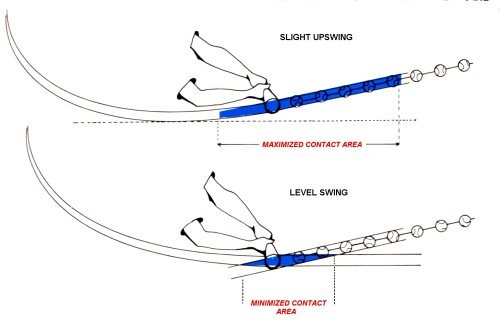
Image from Ted Williams’s The Science Of Hitting. We want the hitter’s barrel path to match the plane of the pitch, not chop down OR put an extreme uppercut on it.
Speed Hitter baseball training aids are flawed for FOUR-reasons:
- Point of contact and when the barrel enters the zone are two different things,
- Point of contact – CLICK HERE for a post I did illustrating point of contact based on pitch depth,
- When Barrel Enters Zone – this will depend on pitch depth – the farther the pitch is away from the hitter, the earlier the barrel should enter the zone. The closer the pitch, the later the barrel should enter the zone, and
- Tampa Bay Rays hitting coach and Speed Hitter spokesperson Derek Shelton doesn’t have an efficient swing himself (wraps the bat in the ad).
Addressing #2 above – The Speed Hitter doesn’t seem to be a hitting aid that lends itself to practicing “point of contact”. It’s more geared for when the barrel enters the zone.
Addressing #4 above – nothing against MLB hitting coaches or any coach on YouTube demonstrating a hitting aid or technique, but there’s always context. There are “snapper” hitting coaches out there teaching every one of their hitters to force barrel back right away, this is great for middle-away and middle-down approaches but terrible middle-in and middle-up – at least WITHOUT significant mechanical compensation to the latter pitch locations (loss of ball exit speed). And then their are ‘down swinger’ coaches who teach the exact opposite of the snappers. Both approaches can work in the right circumstances, but teaching one approach to all hitters is a BIG mistake.
A Better Alternative…The Swing Blaster
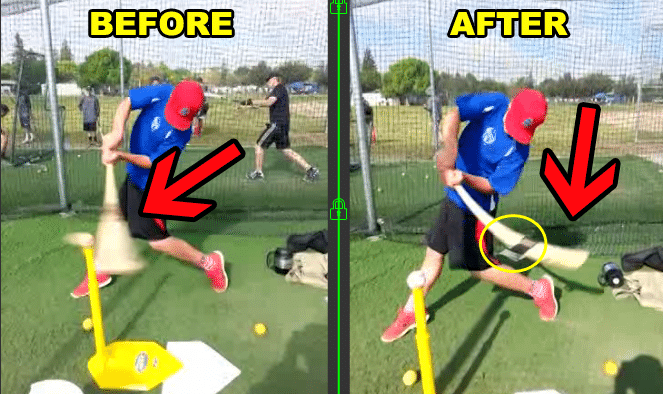
Keenan Wolf, one of my H.S. Frosh hitters, after one 45-minute session using a Swing Blaster demo this past summer. Swings are synced.
FIVE benefits of using Swing Blaster baseball training aids (good for softball as well) are:
- Early Barrel Acceleration – focuses on getting the barrel on pitch plane ASAP. It’s not about being quick to the ball, it’s about being quick to pitch plane.
- Lengthens Hitter’s Pitch Plane – Gives hitter the ability to hit pitches harder – and keep them fair – that they may be late on otherwise.
- EIGHT levels of difficulty – there are eight little ‘washers’ that increase or decrease the level of difficulty to hear the audible “click”.
- Take soft toss – You can use the Swing Blaster to take short range soft toss. A hitter CANNOT do this with Speed Hitter baseball training aids. DO NOT hit LIVE batting practice with it unless the hitter has good bat control.
- MADE IN USA
How does it work?
The Swing Blaster gives a hitter audible feedback in the form of a “click” when max barrel speed has been reached. It’s simple…
If the hitter hears the “click” AND contact at the same time, then they’re doing it WRONG. If they hear a “click” FOLLOWED by contact, then they’re doing it RIGHT. Whereas Speed Hitter baseball training aids have it backwards. They want the hitter to hear the “pop” at contact. To be effective, this isn’t when a hitter should be accelerating the barrel. The barrel should already be accelerated at impact. Impact is when a hitter’s arms are lengthening out or adjusting in to increase turning speed or inertial force.
The price? Get yours today for only $34.99 + shipping on Amazon…I’m not sure if Swing Blaster will be raising the price soon, but for now you’ll be SAVING at least $25 than buying a Speed Hitter. CLICK the following link to…
- Fix Late Swings Fast: 2025 Pitch Recognition & See-Decide-Swing Training for Youth Baseball Power Hitters - October 6, 2025
- Safe Youth Weighted Bat Training: Proven Overload/Underload Drills to Increase Exit Velocity in Games Starting Tonight - September 29, 2025
- AI Coaching Course 2025: Youth Baseball & Softball Practice Plan + Off-Season & In-Season Workout Builder Fast - September 23, 2025

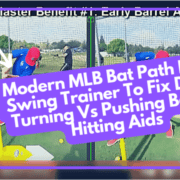


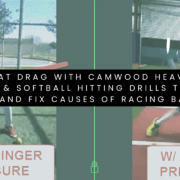
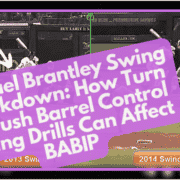

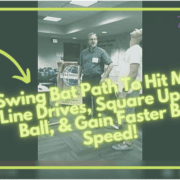
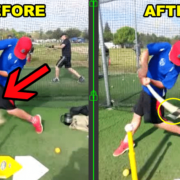

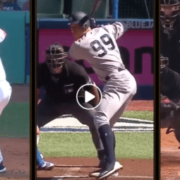



We must be careful not to confuse being “Short to the ball” with being “Quick to the ball”. This short to the ball stuff that’s being pushed now means nothing if the bat is not hitting top speed. It’s like an 800 meter race where one guy claims to be faster because he got to the finish line first, but he ran across the infield of the track, knocked over the Gator Aid stand, cleared a couple of benches, and hurdled a few photographers to get there. You nailed it Joey when you focused on barrel acceleration. If you have to mess with your bat path to get to the point of contact quickly, you need to get faster.
One reason kids have slow swings is because coaches teach them to “Just make contact.” Anyone can just make contact – all you have to do is slow the bat down and meet the ball, and if you have a tin or composite bat and can hit it anywhere on the barrel … off we go. We have to get this philosophy of just hitting the ball out of baseball and start telling kids to hit for the fences. And coaches … don’t give the kid that long-in-the-mouth, disappointed, you-let-the-team-down face when they walk back to the dugout with their head down after they strike out. I go to games and see kids making absolutely horrible swings and just because they made some kind of contact, the coach pats them on the back and says “At least you made contact.” Meanwhile … some 9 year old who can really generate some legitimate bat speed and power swings hard at a bad pitch, and the coach kicks the dirt and says … “Don’t try to kill it – just get on base.” I know of no other sport that tells kids not to try to score. In hockey … we tell kids to try and score. In football, would you tell a kid not to try for the end zone? – just get the ball and run out of bounds – at least you caught it!
Joey … you caught the essence of this point when you suggested to learn to accelerate the bat. Taking the wrong bat path to try and get there sooner is a dead end road.
Bob, thank you for telling it like it is. Great analogy about the 800 meter race. This basically what coaches who use “be short to the ball” cues do to their hitters.
As for coaching behavior, many Little League coaches have had terrible coaching examples growing up. I’m luck to have had two great examples, in High School and College. Most parent/coaches who played football growing up are some of the worst. Great coaching doesn’t change with the sport. There are principles to coaching and learning just like there are rules to human movement. Just ask Tony LaRussa…Bill Belichick…and John Wooden. All based on proven empirical research. There is a coaching standard.
I totally agree with you, just “making contact” is an easier outcome than hitting the ball hard. Hitting a ball that the hitter knows very little about beforehand, with repeatable power, is THE hardest thing to do in any sport. This is WHY Little League should be about getting more efficient mechanically and mental development, NOT about winning. A single minded “winning” mentality, at an early age, leaves young athletes demoralized, with burn out being inevitable. Studies show this!!! Thanks for the comments Bob!
This may sound crazy but I have taught my son to get the barrel in the zone early!!! If I am correct getting in the zone early and getting on plane with the pitch early are slightly different!!! So many times he seems to be slightly under the ball but not because he upper cuts!!! So I guess his barrel path and and pitch plane are slightly different!!! If I am wrong please correct me so I understand better what I am seeing!!! If u have any advise I would love to hear it!!!
Scott, you’re correct…pitch and barrel planes are two totally separate things. The trick is to get them to match. Watch this brilliant video from Perry Husband as he goes over this:
Scott, Honestly it is a great guide to learn new things 🙂 Thank you so much